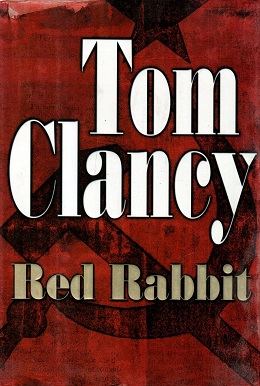🐰 I'm-a the Freakin' Pope...
The Crime: Red Rabbit
The Guilty Party: Tom Clancy
Overview: A spy thriller is short on thrills but long on didacticism.
Why I Hate It...
The arc of Tom Clancy's career is interesting. His debut novel, The Hunt for Red October, is a legitimate classic that blew up the technothriller genre. It stars Jack Ryan, an all-American Mary Sue who's also an aerophobic CIA analyst, who gets in way over his head helping a Russian submarine commander defect from the Soviet Union. The novel spun off a series in which Ryan's exploits get more heroic as the the stakes get ever higher and the novels get ever longer. By the 90s his books were being turned into blockbuster films and video games, at which point Clancy was firmly a genre unto himself.
And then it sort of dropped off around the time Jack Ryan becomes the president of the United States (due to a succession of large-scale terrorist attacks that he failed to stop). The books were overlong by that point and getting incredibly didactic. Clancy was a committed Irish Catholic who disdained both the political left and the fourth estate. Red Rabbit was the second-to-last book that he completed alone, and it's sort of a getting-back-to-the-roots book. Set right after Patriot Games, Red Rabbit is a shorter book that finds the Ryan family in England with Jack once again as a low-level CIA analyst helping a Russian defect. The plot revolves around the real-life 1981 attempted assassination of Pope John Paul II, following the theory that it was a KGB plot in response to the pope's support of the Polish Solidarity movement.
And it really doesn't work. Clancy's books don't follow a typical character-arc structure that you see in most books. Instead, they build narrative tension by creating a sense of inevitability. As you see the complex details behind the mechanisms in play, you form an image of the plot as a train headed down the track towards disaster. Red Rabbit doesn't so much do that. The good guys make a plan, and then they follow through on it. It's about as thrilling as wheat toast. Some of the details we get are interesting, but there's no tension at all, and what tension there might be is thoroughly undercut by the knowledge that Pope John Paul II wasn't killed in 1981--and possibly confusion for those of us who weren't aware that he was nearly assassinated in real life.
What we get with Red Rabbit instead of narrative tension is a series of long stretches kvetching about Britain's National Health Institute. Because the real motivation behind the books seems to have been to take a firm stance against socialized medicine. Indeed, in many ways it felt specifically like a reaction to Bill Clinton's failed attempt at nationalizing health care in 1993--nearly a full decade before the publication of Red Rabbit. I spent a lot of the book asking "But why, though?" and "Is anything actually going to happen?" And, to be clear, I was a hardcore Clancy fan at that point, and yet the preachiness of Red Rabbit was so up front that I was bothered by it, and I didn't even bat an eyelash in The Sum of All Fears when Ryan fixes peace in the Middle East using the power of Catholicism!
Next week we look at another ill-conceived sequel to a Harrison Ford blockbuster, Indiana Jones and the Kingdom of the Crystal Skull...
In CONSUMED WITH HATE, Kurt is revisiting media that he absolutely did not like one bit. See more posts.

Comments